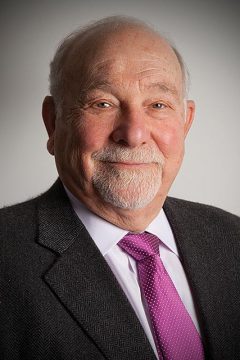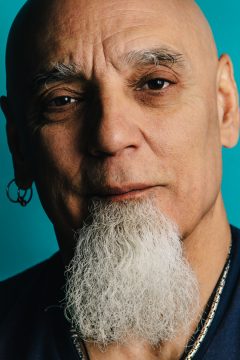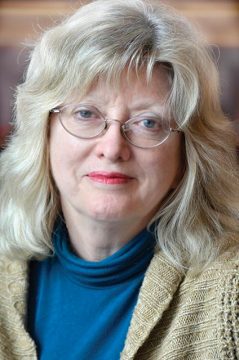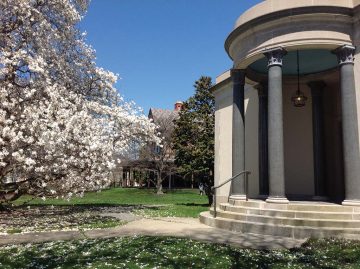
Joseph A. Chazan M.D., photo by Scott Lapham.
In the NetWork s 2008 catalogue, I wrote “the exhibition is an articulation of my professional interest and involvement with Rhode Island artists and visual arts organizations over the past thirty years.…I was very impressed by the artists I met who were in search of excellence. They focused on being innovative while problem-solving as they pursued their creative expressions.”
NetWorks 2009–2010 is a continuation of the process of identifying, introducing and publicizing another twenty-three Rhode Island artists in various stages of their careers working in a variety of media. They are selected by me, in consultation with Umberto Crenca, artistic director of AS220. Considerations include excellence in their media along with contributions to Rhode Island’s artistic community. The videos, expertly created by Richard Goulis, give insight into the artists, who, although they have different stories, uniformly demonstrate the principles of hard work, self-doubt and commitment to excellence. We anticipate these videos will be widely disseminated, and in particular, will be periodically shown on Rhode Island’s PBS station.
The poster and catalogue have been brilliantly crafted and designed by Malcolm Grear and his associates. The exhibition at the Newport Art Museum is expertly curated by Nancy Whipple Grinnell who continues to champion Rhode Island artists and display their work with sensitivity and brilliance. I will also commend Scott Lapham for his excellent portraits, truly capturing the personality of each artist.
With this in mind I present, with great enthusiasm, NetWorks 2009–2010, a project designed to introduce, document, and publicize a group of visual artists who live and work in Rhode Island. I hope that through the videos, in particular, information about the lives and works of the artists will be disseminated to a general audience.
Joseph A. Chazan, M.D.

Umberto Crenca, photo by Cat Laine, Painted Foot.
From its inception two years ago, NetWorks has sought to capture the awesome vitality of Rhode Island’s creative community. Forty artists later, we have yet to fully articulate the power and diversity of this rich culture of artists and makers. Many of our previous NetWorks subjects have proven that although they may be primarily visual artists, creative people inevitably indulge in varied art forms, often experimenting in different media and are socially conscious and socially active. Had we chosen instead to describe our rich musical, dance, film or theater communities, we would find the same to be true. I am profoundly convinced that Rhode Island’s creative community is unique for its density, diversity and influence. It is no revelation that artists are and will continue to be critical to the future of our state.
NetWorks 2010 continues to document and reveal an arts community that grows in spite of economic challenges, provides inspiration with or without public recognition, provides pespective at a time when so many struggle to survive, and graciously shares its gifts with an understanding that “you can’t keep it unless you give it away.” The art enriches, provokes, challenges, informs, enlivens and in so many ways provides all of us access to a world of vision and thought beyond the day-in and day-out. NetWorks is indebted to Rhode Island Public Television for enabling this exemplary local program to reach a statewide audience. Finally, we all owe a special thanks to Dr. Joseph A. Chazan for continuing to be the driving force behind NetWorks.
Umberto Crenca
Artistic Director, AS220
NetWorks and the Working Artist

Nancy Grinnell, photo by Daniel McManus.
It is the “Works” component of NetWorks that particularly intrigues me. As the curator at the Newport Art Museum for the past twelve years, I have observed that artists do work, often with a passion. One of the motivations behind NetWorks, as Joe Chazan states, is to convey the work ethic that characterizes the lives of these artists. When I met Kenn Speiser ten years ago, and we arranged an exhibition at the Museum, it was aptly called “KennSpeiserWorks,” examining the at times laborious process inherent in his meticulous assembling of objects both found and collected. Two weeks ago I listened to Bob Dilworth, painter and chair of the art department at the University of Rhode Island, describe how he combines his administrative job with his creative life; he spends his Saturdays from 8 am to midnight painting, and begins to ease back into his “work” week on Sunday evening. Making a career as an artist is an uphill battle in the business and corporate ideology of today’s United States, and it has been that way for centuries. The work ethic attributed to the Puritans did not necessarily include being an artist; art was considered a vanity and a frill, and that philosophy still holds today, as evidenced by a recent comment from a friend’s husband: “artists need to get real jobs!”
The feeling of an artistic “calling” is prevalent in many of the NetWorks artists’ biographies, despite parental objections. This situation has precedents; one of my favorites is the artist Charles Woodbury (1864–1940) who graduated from MIT with a degree in mechanical engineering; soon after, he turned to a career in art and art education, stating that for him “mechanical engineering hath no charms.” Legendary Rhode Island School of Design instructor and painter Tom Sgouros recalls that art was third on his list after being a lawyer or doctor, as per his father’s wishes. When macular degeneration ended his career as an illustrator, Sgouros had a second calling as a painter of “remembered landscapes.” Glass sculptor Steven Easton feels that he was “put on this earth with the ability and inclination to be creative,” and follows through with an intensity of purpose and thoroughness of research to his art historical sources. Agustín Patiño, from Ecuador and living in Providence, says “art is fundamental, part of my blood, part of my concept of life.” Patiño’s fantastical and at times surrealistic murals and paintings are charged with metaphors about civilization and its questionable direction. Internationally acclaimed designer Malcolm Grear, coming from a rural Kentucky upbringing and serving in the Navy as a metalsmith, found that graphic design guided by “purposeful communication” was his objective. Stephen Brownell trained as a botanist, but discovered a personal need to document in paint the mill buildings of Providence that were being demolished.
There is little that is rote about being a working artist. Part cerebral, part hands-on, the methods of making art are physically and mentally challenging, time-consuming, energy-sapping and by turn, both frustrating and exhilarating. For Tony Ramos it is all about the process: the canvas, the stretcher: “It’s a Zen thing,” he says. Stephen Brownell says it is the process that makes him feel like an artist: initial ideas recorded in sketchbooks, decisionmaking as to “what gets made and what gets forgotten.” In her “bird-disaster series,” Leslie Bostrom, an associate professor at Brown University, makes many drawings and watercolors, seeing it as working out the problems in a complex narrative. The “process” can be very satisfying, as in the work of Donna Bruton, who finds the act of collaging essential to her “language of abstraction,” or Kenn Speiser, who might be carefully positioning hundreds of push-pins or hand-punching as many discs of color film. In Speiser’s work, as in that of Neal Walsh and Coral Bourgeois, the grid is a motivating structure. Walsh often uses a grid as a foundation, layering his paint and found materials, adding and subtracting in a way that he says is similar to nature’s patterns of growth and decay, chance and control. In her tiles, Bourgeois also loves the grid, playing and delighting in color and combinations of texture, paint, abstraction and realism, pattern and image.

Newport Art Museum, Courtesy of the Newport Art Museum.
NetWorks is a restorative project in many ways, not least of which is that it begins a dialogue with artists and their work. A prevailing sentiment that I have encountered in my years of studio visits is that artists spend so much time with themselves and their work that they lose a bit of perspective and develop self-doubt. James Reynolds, a RISD graduate who found his niche when he studied tin-smithing in a small town in central Mexico, occupies a massive studio where he creates large scale repoussé metal panels, both for commercial and other venues. Reynolds contemplates the concepts of time and beauty; the images in his personal pieces are often disembodied and psychologically compelling, with references to both religion and art history. Similarly, Steven Easton feels a connection to the “the mysteries of nature, cultures past and present, and artifacts of antiquity.” Astrid, an American artist born in Cuba, works tirelessly in her studio at AS220, where she has become well known for her spontaneous yet spiritual imaginary portraits. Inspired by East Asian calligraphy, she uses sumi ink and brushes. After much soul searching, Astrid is ready to reinvigorate line and color and has new work that is very different. Artists who also teach or work in the visual arts interact daily with other artists. Neal Walsh, who runs the Project Gallery at AS220, finds that seeing other people’s work spurs him on to do more of his own; he finds painting to be a meditative experience. Ben Anderson, a sculptor, environmentalist and assistant professor at the University of Rhode Island, says that artists should be out searching, seeking to make visible what is often invisible.
Whether introspective or extroverted, these NetWorks artists all have a need to express themselves in an original and profound manner. Nicole Chesney, who paints on etched glass, finds a catalyst in the philosophical writings of Gaston Bachelard (1884– 1962), who believed that an artist’s job was to convey a sense of wonder. Chesney’s glowing, otherworldly glass panels do speak of wonder, but the artist must address a host of more practical considerations in her work life including how to please clients and ship her large, fragile work. Wendy Wahl is also inspired by literature, although her references are more literal: she transforms discarded Encyclopedia Britannica pages into sculptures and installations. With her materials and forms Wahl wants to create a “tactile text” that challenges our assumptions about our surroundings. Donna Bruton strives to create art that will transcend our consciousness; in her abstract paintings she makes associations between objects both real and imagined. Erminio Pinque is the founder and artistic director of BIG NAZO, an international performance group of visual artists, puppet performers and masked musicians “who create bizarre and hilarious larger than life size characters…” For NetWorks, Pinque is taking his MEGO character out of retirement and has made revisions to his structure and surface color. According to Pinque, MEGO is not simply a sculpture or a puppet head, but a “ritual transformation persona that has evolved through time, circumstance, exposure to the elements and interactions with the performer who plays him and the audience watching.”
The NetWorks project reflects a very diverse group of working artists. There are those who react to the world around them, hoping to raise consciousness about environmental concerns, war and brutality. Caricature and creatures seem to play a large part in the art of some of today’s more edgy artists. In her large oils Leslie Bostrom blends a cartoonish portrayal of wildlife with frightening images of hunters to examine issues in nature. William Schaff looks at the flawed society around him and interprets it in figurative drawings and paintings of sinister looking characters. In Schaff’s work there is a fine line between popular culture, fine art and social disintegration, almost akin to the distorted works of the German Expressionists after World War I. Addressing issues of ethnicity and identity is integral to photographer Annu Palakunnathu Matthew and painter Bob Dilworth, both associate professors at the University of Rhode Island, which supports their research. Matthew, born in England of Asian Indian parentage, uses a Holga camera and a computer to manipulate her photographs which address the immigrant experience and more specifically, her cultural identity as an Indian woman living in the United States. Dilworth’s vibrant new figurative paintings are about his roots in small town Virginia, which remains a very different place from the technologically sophisticated urban settings to which he has become accustomed.
Other NetWorks artists respond to external stimuli: light, nature, mathematics, the cosmos. Glass sculptor Daniel Clayman wants his work to look like he “wrestled a light beam out of the air to create a tangible object.” Clayman works on a large scale which in itself necessitates a very sophisticated operation. Printmaker Yizhak Elyashiv, born in Israel, employs mathematics and measurements to conceptualize 3-dimensional space into 2-dimensinal works. He wants to make “a connection between the hand and the horizon.” Tony Ramos, after a noted career as video artist and political activist, experienced a passionate return to painting in the 1990s, drawing on deep space and cosmic forces to depict patterns of circles and squares, arrows or dots over gestural surfaces. The improvisation of jazz, the abstraction of aboriginal art are also important influences. Photographer McDonald Wright pursues the formal aspects of the medium; for him “photography is painting with light.” Both in his photographs of water and jazz performers, Wright continues to experiment with the technology of the film camera, using a medium format manual camera and partial frame advance to induce abstraction in his subject matter.
The multi-media, multi-cultural project that is NetWorks serves as a model for arts ventures of the future. The videos, the photographic portraits, the special events, the exhibitions, the discussions, the marketing, ensure that there will be an audience that views artists as fundamental to society—and recognizes that these artists are seldom one-dimensional. Umberto Crenca, artistic director of AS220, points out in his statement, “creative people inevitably indulge in varied art forms, often experimenting in different media and are socially conscious and socially active.” Museums and libraries are reexamining their missions in light of the changing culture around them; former “temples” are becoming lively centers of interaction; NetWorks fits right into this new vision. With appreciation to Dr. Joseph Chazan and AS220, I am privileged to be part of it.
Nancy Whipple Grinnell
Curator, Newport Art Museum